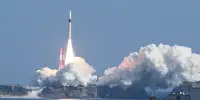Maglevs are one of those technologies that, even after years of use, still appear to be magical. While they have long been a workhorse of several big cities’ transportation networks, they rarely have an impact on the day-to-day lives of those who do not utilize them to commute. However, they may be useful in another context—lunar exploration. A team from JPL and a company named SRI International believe they have found a solution: deploy a maglev track on the moon.
The Flexible Levitation on a Track (FLOAT) system is a straightforward concept. It is based on an SRI concept that demonstrates the capacity to float miniature robots across a platform and accurately control their movements using magnetic levitation. As seen in the video below, the technology is still on a limited scale. The FLOAT team, on the other hand, was awarded a NASA Institute for Advanced Concepts (NIAC) funding to investigate how scaling up the technology would operate on the moon.

The track is arguably the most important aspect of the technology. It is made up of two required layers and one optional layer. The base layer is graphite, which allows robots to float above the track via a force known as diamagnetic levitation. A second layer consists of a set of circuits that control the magnetic fields around the track, allowing users to push or stop moving carts. The optional third layer is a set of solar panels that can collect solar energy while the moon is in daylight.
An key item to note is that the carts do not need to have any brains of their own. The track provides both power and control for the carts; there are no batteries, logic, or other components on the carts themselves. This reduces the weight of the cart itself, allowing it to carry more items.
Another intriguing concept presented in the team’s final report is that the FLOAT track can be made in a facility and then deployed by a rover by pulling it from a spool. The track’s components are flexible, making the spool an excellent deployment technology and greatly lowering the cost, especially when compared to traditional road building here on Earth.
Another advantage of the FLOAT system is that it does not stir up dust once it is in place, which could be one of the most perilous aspects of lunar exploration. According to the team’s calculations, they could elevate the carts more than twice the height of a normal lunar dust particle, allowing them to move down the track without disturbing any existing dust. Because there is no air on the Moon’s surface, big levitating carts will not disturb the dust on either side of the track as they pass.
However, dust may build on the track, especially when it is first deployed or if other activities (such as ice mining) are taking place nearby. If this occurs, the FLOAT system may use a specially built cart with a broom mounted to the front to sweep the dust off the track before ordinary carts resume operation.
Even slopes don’t appear to be a problem—calculations in the final study suggest that carts could go at respectable rates up and down 30% grades without requiring excessive power. This capability might greatly expand the track’s coverage area and enable even more facilities to be connected to the FLOAT network.
The key word here is connectivity, as spooling technology would allow tracks to be deployed to any number of locations, whether economic, scientific, or logistical. However, one of the major challenges in scaling up technology is figuring out how to connect all of those spokes. Connecting two sections of the floating rail is a hurdle that must be overcome if the technology is to be used.
Adoption is likely still years away, as the Artemis missions that would begin constructing the lunar infrastructure that would necessitate such a system are still years away. According to the team, they could have a workable system by the mid-2030s, just around the time a permanent lunar base will be operational. But, for the time being, it’s unclear what the project’s future holds—there aren’t any notable publicly known financing sources. However, when we establish a permanent presence on the moon, there will surely be a need for a strong transportation system, which perhaps a future version of FLOAT will offer.
















